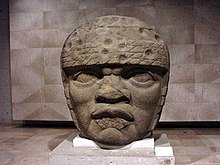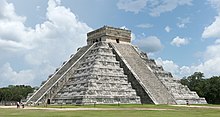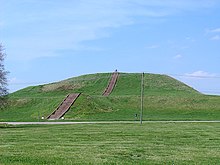World History/Precolumbian History of the Americas
Maps | Resources | Contributors' Corner
Early Civilizations of Mexico and Mesoamerica[edit | edit source]
The Olmec[edit | edit source]

The Olmec rule lasted from 1200 BC to 600 AD in the swampy lowland regions of Mexico. To deal with this climate, the Olmec built permanent city-temple complexes at sites such as at San Lorenzo, Tenochtitlán, La Venta, Tres Zapotes, Chalcatzingo, and La Mojarra. Olmec culture originated at San Lorenzo, where distinctively Olmec features began to appear at about 1150 BC. As in Mesopotamia, ancient Egypt and other early civilizations, the emergence of the Olmec civilization was assisted by fertile, well-watered alluvial soil.
The Olmec were known for their art, which usually reflected their religion. They created ceramic vessels, figurines, and the unexplained enormous carvings of heads. The jaguar is an important motif throughout Olmec art.
In about 900 BC, San Lorenzo was all but abandoned, and La Venta became the primary city. The reasons behind this move are unknown, but it may have been due to environmental changes or invasions. By 400 BC, La Venta also came to an end.
Teotihuacan[edit | edit source]
The Mixtec[edit | edit source]
The Zapotec[edit | edit source]
The Toltecs[edit | edit source]
Rise and Fall of the Maya[edit | edit source]

One of the three most powerful and interesting cultures to thrive during the Precolumbian period was that of the Maya, which centered on the city of Tikal in the Peten section of Guatemala (delete "the Yucatan peninsula of Mexico"). Though the Maya had existed for some time beforehand, the dates of 300 BC to 800 AD are the most accurate for the height of Maya culture. The Golden Age of the Maya might be described as about 500 to 850 AD, during which the most complex and fascinating parts of Maya culture were invented or built. The Maya political system involved, like other early civilizations, a system of city-states. However, a single king held sway over all the principalities. Mayan religion and daily life were very intertwined. Because of the importance of maize (corn) in their culture, the Maya believed the gods had created them from a stalk and water. They also created elaborate rituals involving dance, sacrifices, and some blood-letting to please their gods. They based their faith on a heaven, the earth (in the middle) and an underworld.

Maya life centered on agriculture. Because of the ease of its growth, the Maya relied heavily on maize as their staple crop. In addition, cotton was grown in abundant quantities and the Maya are known for their cotton textiles. Because the Maya had no large animals, slavery became widespread as a way to solve the labor shortage created by the animals' absence. The Maya were sufficiently developed enough to have a class of skilled artisans and a priesthood. Social structure held the king and nobles at the top, followed by priests, the merchant class, the peasants, and finally slaves. As in other ancient cultures, the peasants and slaves made up the majority of the Mayan population. The slaves were used to construct massive cities, such as Tikal and Chichen Itza. The tiered temple at Chichen Itza (the place of the Itzas or priests) is the greatest remaining relic of the Maya, and is similar in construction to Egyptian step pyramids. During the Fall Equinox on September 22 (and also at the spring equinox on March 21) one can witness the incredible accuracy of Mayan astronomy as it was integrated into architecture. The equinox phenomenon can actually be viewed in Chichen Itza on the El Castillo pyramid for up to four days. During the equinox the sun casts its rays on the pyramid, forming seven isosceles triangles that resemble the body of a serpent 37 yards long slithering downwards until it joins the huge serpent’s head carved in stone at the bottom of the stairway. It is said this snake is trying to make its way to the Sacred Cenote well of sacrifice which is in a straight line from the pyramid. Also at another nearby site, Dzibilchaltun, September 22 at 5 AM is the official day and exact time of the fall equinox when the sun sends its beams through the two windows of the Temple of the Seven Dolls providing a lovely spectacle of Mayan exactitude.

The Maya developed a complex scientific and mathematical knowledge throughout their existence. Their precise astronomical observations allowed them to develop a calendar almost as accurate as our own today. In mathematics, they developed a number system based on bars and dots, and pioneered multiplication and division. They were also the first in the New World to come up with the concept of "zero" (which is not just as in nothing - think as a placeholder in the number 10,000). The number system was also highly accurate. An ingenious alphabet allowed the Maya to record information on their monuments and temples, giving anthropologists an excellent way to learn about Maya life and culture. The system of writing the Maya developed was based on pictograms. Modern science has managed to decipher much of the alphabet.
The Maya began to decline in about 800 AD until the Maya disappeared completely from observable history. Although the cause is unknown, the standard answers of disease, drought, famine, or internal unrest are given. New evidence seems to lend some credence to the thought of a drought-famine connection, but this is unconfirmed. Whatever the reason, the Maya began to abandon their cities which shrank back into the jungle to await discovery by modern archaeologists. Interestingly, a small group of ethnic descendants still live in the jungles of the Yucatan, where they practice a mix of Christianity and traditional religions, as well as speak the same language as their Mayan ancestors.
The Putan Maya[edit | edit source]
After the fall of the Maya and a period of unrest, the city-state of Chichen Itza developed a confederacy in the north of the Yucatan. The confederacy limped along until around the 13th century when the center of activity was removed to Maryapan, whose rule lasted until about 1450 AD.
Further south, a relatively powerful group known as the Putan Maya established itself in the southwest of the Yucatan peninsula. The main city of Xicalango became the center of a powerful post-classical period maritime trading network which flourished from around 900 AD until the arrival of the Spanish conquistadors. The Putan Maya also established trade centers at Cacaxtla and Xochicalco, for interaction with the Toltec. The Putan Maya were heavily influenced by the culture of the Toltecs. In addition to the Putan Maya, several small kingdoms existed throughout Mesoamerica and Mexico under Mayan control, which made the area more resistant to invasion when the conquistadors arrived than their unfortunate cousins in Tenochtitlan.
The Aztecs[edit | edit source]

The Aztecs were one of the most memorable of all of the ancient Mesoamerican empires. They were located in central Mexico right where Mexico City is today.
Early civilizations in South America and the Inca[edit | edit source]
The Moche[edit | edit source]
The Nazca[edit | edit source]
The Sican and Chimu cultures[edit | edit source]
The Inca[edit | edit source]
Native American cultures north of the Rio Grande[edit | edit source]

Native American cultures were not as sophisticated as the Mesoamerican or Andean civilizations. Even Cahokia, the largest Precolumbian settlement in the modern United States, had only a small fraction of the population of cities like Teotihuacan or Cuzco. There was no writing north of Mexico, and the ancient civilizations of the Mississippi and the Southwest had long crumbled away by the time Europeans made substantial contact with the natives there. Therefore, study of the history of North America heavily relies on archaeology.